 There are generally two chains of thought about the purpose of our education system. One is that they exist to give students both the learning skills required to locate and digest information, and the love for learning that encourages them to constantly live on the hunt for new things. The other is more utilitarian and suggests that schools exist to provide people with the skills to then become effective members of society.
There are generally two chains of thought about the purpose of our education system. One is that they exist to give students both the learning skills required to locate and digest information, and the love for learning that encourages them to constantly live on the hunt for new things. The other is more utilitarian and suggests that schools exist to provide people with the skills to then become effective members of society.
The demands of a social business probably fall between the two, but I’d like to focus today on the former and on how schools can prepare young people for the way they will work when they enter the workforce. I’ve written previously about various attempts to bring collaboration into the classroom, and a major element of these initiatives is to remove the boundaries that exist in the classroom and encourage students to collaborate with other people on their work.
This intellectual diversity is a fundamental aspect of crowdsourcing, and indeed for the strong performance of many groups of knowledge workers. Just as professionals should be open to exploring and connecting with people from different companies and industries, so too should students. This ability to locate information and knowledge from outside your immediate confines is an invaluable skill to develop.
So, if you’re a teacher looking to bring a more collaborative style to your classroom, how can you get started? Here are a couple of ideas that might get you going. Most are pretty low tech so should be possible with minimal outlay.
- Collaborative problem solving – a lot of academic work is done in isolation so that teachers can then grade performance. Try instead to post a question and then allow students to openly tackle it, akin to how crowdsourcing challenges work. This can be achieved either in a physical environment or via something like Google Docs.
- Collaborative learning – learning from the teacher is great, but learning from each other is much more common in the workplace. The collaborative classroom should therefore be one where students are not only helping each other with the answers, but also with the working out. Sharing notes and research can be a great way to help other students develop.
- Collaborative research – with social media it’s easier than ever before to tap into the thoughts and insights of subject matter experts. What’s more, it’s increasingly straightforward to coral those findings into a narrative that can be shared with others. For instance, students could follow an expert online, and then summarise their findings into Storify for their peers.
- Crowdsourcing quantitative research – it has never been easier to produce a survey or other quantitative research tool, and then recruit participants in that research, whether that’s from a platform such as Mechanical Turk or from opening up the survey to participants on Twitter via a hashtag.
- Collaborative analysis – in #3 we spoke about following thought leaders and digesting their thoughts. It’s also good practice to analyse these thoughts to determine if they remain worth following or not. This can be done collaboratively as a group exercise to train students in the art of analysing the credibility of both information and its source.
These are five really straightforward ways to bring collaboration into the classroom. Let me know your thoughts in the comments.
I used to work as a network systems and applications architect (that of course was just the final phase of a career that included programming, coding, system administration, etc, etc, etc). Then I retired and now I write. However, the final focus of my former career was collaboration and systems that encouraged and facilitated collaboration. There is no doubt that it is the way work gets done and we need more of it. Unfortunately, the people who now control schools want no parts of it. They have another agenda that you didn't mention in your article. Ever since the establishment of the U.S. Department of Education, the agenda has been indoctrination. Ideological indoctrination. Which each passing year, more and more of our schools' budgets have been funded by the DoE and their influence has grown. Common Core is simply the latest step in their agenda of indoctrination.
We need to look at thinking like that which you propose. We need to inculcate the love of learning into children. We need to teach them how to study and teach themselves collaboratively and effectively. We need teachers who will stand at their sides offering aide and encouragement. However, we first need to eliminate the barrier that stands in our way, the DoE.
Agree with you Jack. Education seems to be muddled wherever you look in the world.
Good comment Jack. Like you, it seems here that schools are designed to churn out automatons with certain facts in their heads rather than people prepared with the skills required to make an impact on society. It really is a shame.
We should take our job of making sure that each child has the opportunity to learn very seriously. This is all new to the child. We want it to be the best experience it can be. That will draw the child into a love of learning and onto college. That is everyone’s job, that the child has a great experience of going to school.